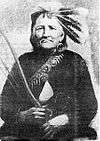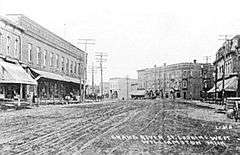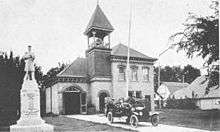History of Williamston, Michigan
The following article describes the history of the city of Williamston, Michigan, located in Ingham County.
Before Written History

The area that was later to become Williamston was the 'summer home' of a group of Chippewa people (a band among the Ottawa tribe). This land was used by them for planting what few crops they needed, holding an annual 'spring gathering' of related bands of the tribe, and burying the dead.
The most famous native American resident was Okemos, whose name survives as a postal address in nearby Meridian Township. Okemos ("Little Chief" or chief of subordinate authority—it is unclear if his name was meant to reference his stature—he was described as short by many contemporaries—or his authority—he had few if any directly subordinate tribesmen) had a relatively well-documented life. An ally of the British in the War of 1812, he was so badly wounded during an attack on a U.S. Cavalry unit near Sandusky that he bore a four- or five-inch-long scar from a saber on his left forehead the rest of his life. (See for example, Michigan Pioneer and Historical Society Collection, Vol. XXVII. Indian Funeral Scene. M. D. Chatterson. Lansing, MI: Robert Smith Printing Co., State Printers and Binders, 1897 for more detail.)
Beginnings of European Settlement

The region that was later to become Williamston was first settled by people of European ancestry in 1834 by Hiram and Joseph Putnam, who moved to the area from Jackson, Michigan. When moving, the two cut an approximately 20-mile (32 km) road through the dense forest between what is now Stockbridge and the Cedar River (now called the Red Cedar River). This road still exists today as Williamston Road, and, inside the Williamston city limits, it is named "Putnam Street" in the family's honor. Upon arriving in the area, the two made a 15-acre (61,000 m2) settlement on the north bank of the river on a former Native American planting ground, built a log cabin, and started farming the land.
Phelpstown / Williamstown
After only one season of poor farming, the Putnams returned to Jackson, abandoning the land. In 1838, a settler named David Phelps moved to the region from New York State. He started a small settlement which, along with the present-day townships of Locke, and Williamstown, became known as "Phelpstown". In 1839, the Putnams sold their land to Oswald B., James M., and Horace B. Williams, three brothers who came from Batavia, New York. James M. "Miles" Williams, who built a dam, saw mill and later a grist mill in town, eventually platted the land in 1845. The Michigan Legislature divided the original township into the two present townships in 1842, and changed the name of the eastern-most section to "Williamstown" in 1857. It is unknown how the Village lost the "w" in its name, however, the Township as it exists today retains the original spelling.
The town was a popular stop on the Grand River trail (that later became a plank road) from Detroit to Lansing in the 19th century. That trail is now Grand River Avenue (M-43) which runs through downtown Williamston. Because the primary means of transportation at that time was the horse and buggy and because the trip from Detroit to Lansing often took more than one day, Williamston became a convenient overnight stop.
Modern Williamston

Williamston was incorporated as a village by the Michigan Legislature April 5, 1871, the same year the Howell and Lansing railroad from Detroit to Lansing sited a depot in Williamston as one of the intermediate stops. From this time until about World War I Williamston was the commercial and social 'hub' of the farming and early industrial society in Eastern Ingham County. After the war, the industrial growth in the area concentrated in larger cities such as Lansing and population of Williamston stagnated as many younger residents left rural life for the city, and the businesses supporting them followed.
Williamston was incorporated as a city by vote of the population on April 1, 1945. A later revised City Charter was adopted by the people effective in April 1963. This charter has been amended several times, but remains in effect today.
A history for the area was published for the City's centennial celebration in 1971. It included many photographs and stories (and more than a few errors!) of the early city and its inhabitants. There were earlier histories, as well, published in 1963, the 1930s, and in 1880.